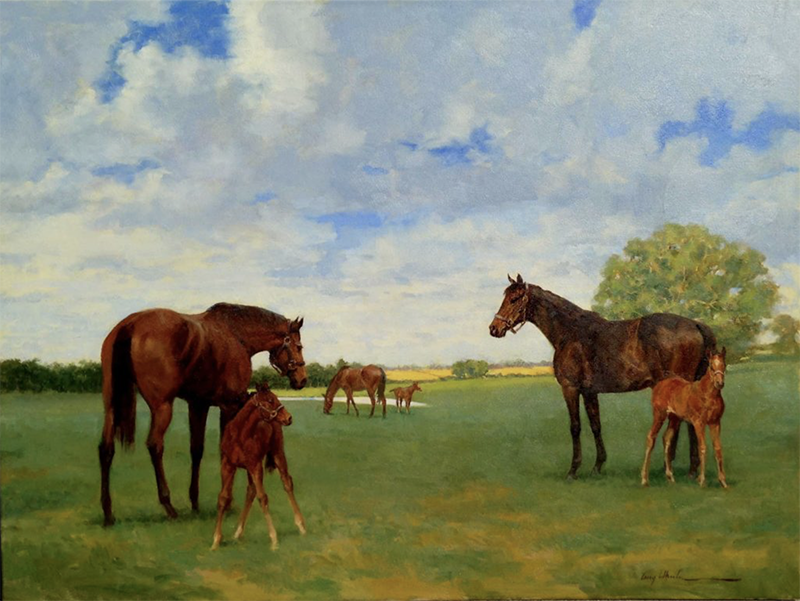
by Brooke Chilvers
What a great excuse to exit I-95 on our trip back north – going to meet the artist whose stylish fox-hunting scenes of mounted hunters capture both a certain feeling and a certain light.
I’ve admired Wheeler’s oil canvases for several years now in Charleston’s Dog & Horse Fine Art & Portraiture Gallery on Church Street, where Jaynie Spector introduced me to his work, telling me also that Larry and his wife, Karen, are the nicest possible people, which turned out to be true.
Penny Chenery, who bred and raised the champion thoroughbred racehorse, Secretariat – and owned at least five of Wheeler’s paintings – wrote about Wheeler in Equine Image magazine, “His use of light in landscapes and to highlight animals is the most appealing aspect of his work.” Mares and Foals is a perfect example.
The pearling light in Hounds in the Shade finds its reflective planes on canine foreheads and haunches that catch and throw off hues of white, while keeping the damp grass cool in the hot Georgia summer.

Larry (b. 1942) is a quiet man, with lovely Georgia manners, whose love of landscapes dates back to childhood adventures along the Chattahoochee River, near his home in Marietta, where he boated and fished. Already in high school, his art instructor was a “direct descendent” – art-wise – of John Singer Sargent, which affected Larry’s own impressionistic brushstroke. “Thus began my painterly lineage,” recounts Wheeler, who also cites Thomas Eakins and Sir Alfred Munnings as important influences.
Wheeler studied art at the Maryland Institute College of Art in Baltimore, where he came under the influence of the “school” of the controversial Frenchman Jacques Maroger, who’d devoted himself to analyzing the formulas and reproducing the mixing techniques of the Old Masters. This led Wheeler to closely examine the works of Rubens, Vermeer, and Velasquez.
His study of the finest artists continued when he became painting conservator at the Corcoran Gallery and at the Smithsonian Institution, until he turned fulltime to painting in 1980. “I was in daily contact with works of Rembrandt, Remington, Moran, the American Impressionists…,” writes Wheeler, who was drawn to figurative painting and Realism when the art world was dominated by abstract and conceptual art.
But his own style emerged, “separate and apart from any school or movement,” he emphasizes. His brushstroke and use of light are easily recognizable and draw you across the gallery floor, inviting you to come closer.
Wheeler makes a point of painting what he sees, which requires real knowledge of the working parts of his horses and dogs – all that interaction between bones and joints and musculature and skin – that comes only from hands-on contact with the subject.
In broad terms, Wheeler is an equine artist. But from the works in his studio, it’s obvious he can paint whatever inspires him, from Palm Beach polo matches to the landscapes of his daughter-in-law’s native Thailand.
He first came to equine art many years ago after his first visit to Laurel where he observed the horse he was commissioned to paint, Spectacular Bid, going through all the moves of his workout, which cemented his desire to “become part of the horse industry as a recorder and witness to the beauty of the breed and the immense constellation of players that sustain the equine landscape.”
Wheeler’s knowledge of hunt country and timber races comes from years of painting the “breeding farms and training facilities… the horses and the people who breed, train, race, show and ride them — and their environments,” writes one critic.
For years the Wheelers lived “in the verdant rolling hills of the mythic ‘My Lady’s Manor’ lands,” where life, he said, “revolved around the Greenspring or Elkridge-Hartford Hunts, Laurel Race Course (today Laurel Park).” And, of course, Pimlico; Virginia hunt country was just next door, and he also spent months every year at Saratoga Springs.
Now, sitting in his studio, bathed in the spring light filtering through the magnificent live oaks that fill his neighborhood, it feels like we’ve been painted into one of his canvases.
______________________________________________________________________________
Brooke says that in her part of Virginia, I-81 stands for 80 trucks for one car. “Still, the scenery is better than on I-95.”
